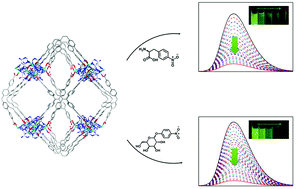A biological luminescent metal–organic framework with high fluorescence quantum yield for the selective detection of amino acids and monosaccharides†
Abstract
The biological luminescent metal–organic framework (bio-LMOF), (Me2NH2)2[Zn6O(Ade)4(TCPPE)2] (1) {H4TCPPE = tetrakis[4-(4-carboxyphenyl)phenyl]ethene, Ade = adenine} was successfully designed and synthesized under hydrothermal conditions, with two channels of different sizes. The absolute fluorescence quantum yields of complex 1 and activated 1 are up to 77.6% and 85.9%, respectively. Activated 1 exhibits outstanding water stability and excellent selective luminescence sensing for amino acids and monosaccharides. The fluorescence quenching efficiencies of activated 1 towards L-Nph and D-Nga are 86.35% and 91.60%, respectively. Besides, activated 1 also displays highly quenching responses to L-Nph and D-Nga at fairly low concentrations, and the limits of detection for L-Nph and D-Nga are estimated to be 0.149 ppm and 1.612 ppm, respectively. Meanwhile, in multiple cycling experiments, activated 1 still has excellent cycling stability. These phenomena indicate that activated 1 can be utilized as a fast responsive biological luminescent sensor, which is a rare example for bio-LMOFs.



 Please wait while we load your content...
Please wait while we load your content...